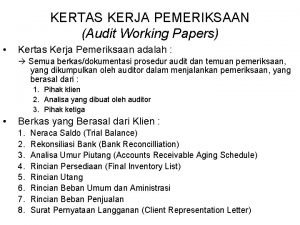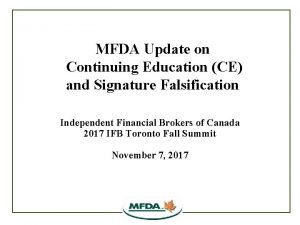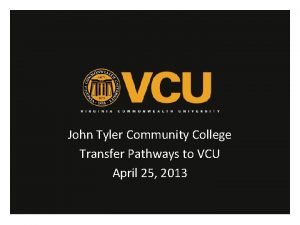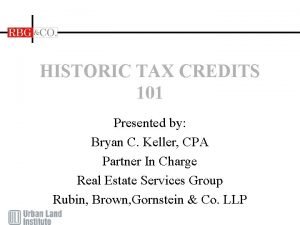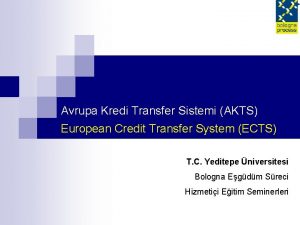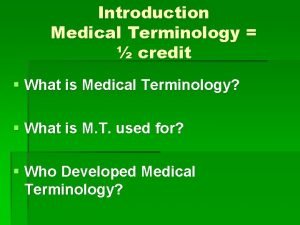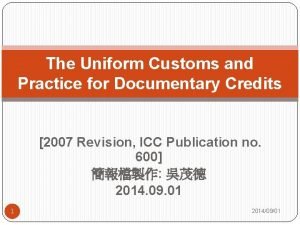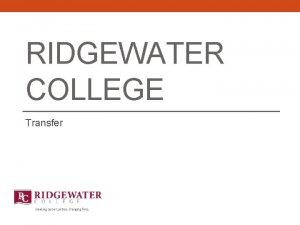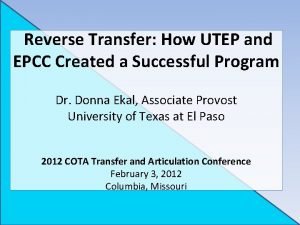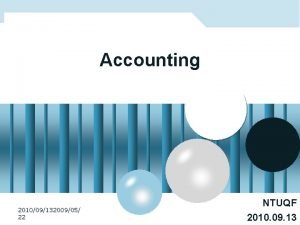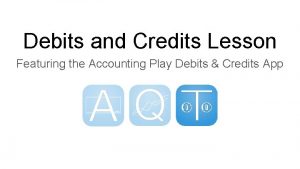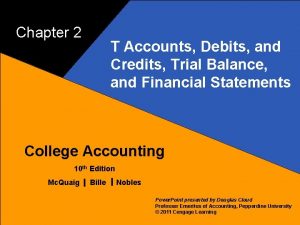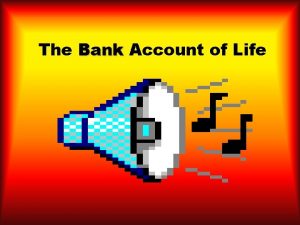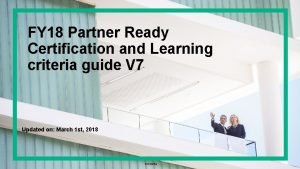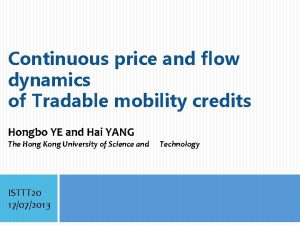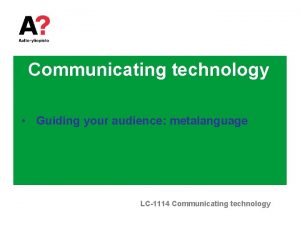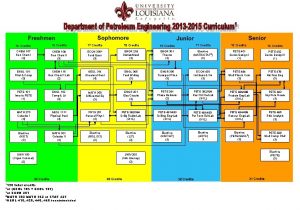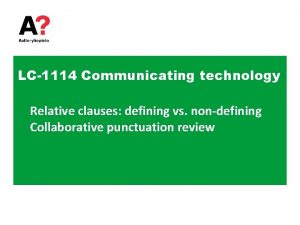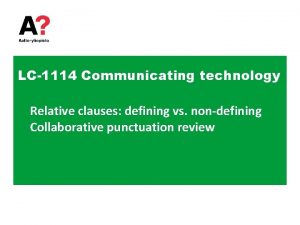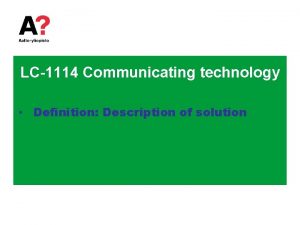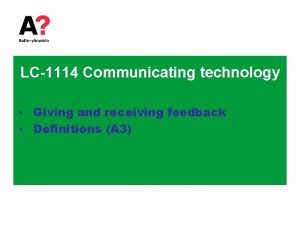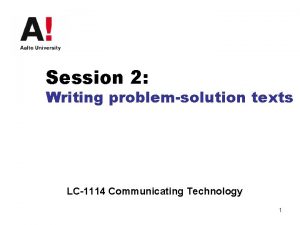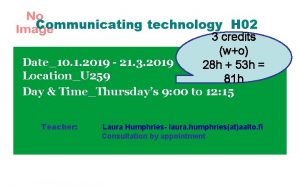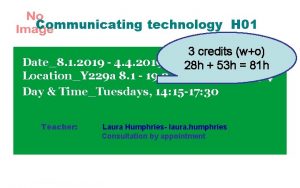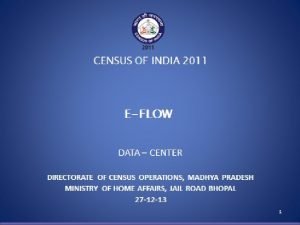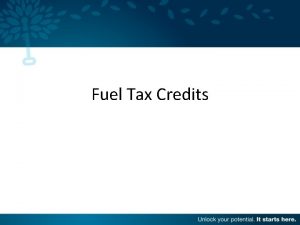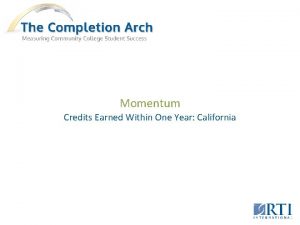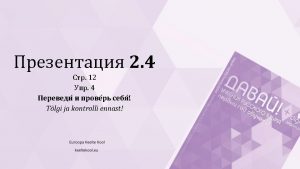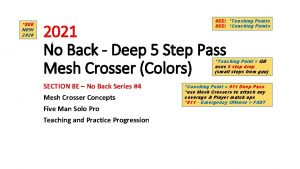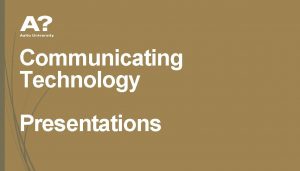LC1114 Communicating technology 3 Credits See Schedule For




































- Slides: 36

LC-1114 Communicating technology 3 Credits See Schedule For Course & Assignment Details By: Laura Humphries Contact: laura. humphries@aalto. fi

What does this course aim to do? • Enhance clarity and audience-friendliness - in writing related to your field of study - in an oral presentation • Help you distinguish between formal and informal styles of communication LC-1114 Communicating technology

Why bother ? § Globalism: LOTS of engineering graduates → field-knowledge only is not competitive § What will give you a competitive edge? 1. Communication skills 2. Strong English skills LC-1114 Communicating technology

Why bother ? § Innovation – created through cross-disciplinary interaction § Wider Audience – Non-engineers (Business, Design) – Decision makers Funding € £ $ ! § Multicultural Teams - English used as working language - General communication skills LC-1114 Communicating technology

What will I know by the end of this course? § Principles of readability Can I read this? § Effective oral presentation Organization Slides Delivery § Formal vs. informal English Vocabulary choice Grammar LC-1114 Communicating technology

What will I know by the end of this course? § Present information clearly to non-experts § Adjust my style depending on the genre and my audience § Receive, give and use constructive feedback § Use English more confidently to communicate MY ideas LC-1114 Communicating technology

What will I do during this course? § Participate and contribute to class work § Plan and write texts § Complete 3 online modules independently § 1 Exam (in-class, written) § Oral presentation (based on the written work) § Give and receive peer feedback § Review and improve my work based on feedback LC-1114 Communicating technology

What will I do during this course? . Preparatory Assignments (X 7): Graded Assignments (X 3): A 1 Pre-course assignment P/F (5%) § EXAM: 0 -5 (20%) (Style and readability principles) A 2 Introduction paragraph P/F (5%) § Final report: 0 -5 (25%) A 3 Definition of solution added ¨P/F (5%) (A Recommendation) - Peer feedback! § Oral presentation: 0 -5 (25%) A 5 Presentation outline P/F (5%) A 6 Rehearsal and slides P/F (5%) - peer feedback! A 7 Self-evaluation and analysis P/F (5%) Prepartory Assignments = 30% Graded Assignments = 70% LC-1114 Communicating technology

Grading Scale for Graded Assignments Grade 0 -5 5 93 – 100% 4 85 – 92% 3 77 – 84% 2 69 – 76% 1 61 – 68% 9

Do we have any course materials? 1. Writer’s Guide for Engineers Pdf-file in My. Courses 2. Lecture slides § Pdf-files in My. Courses 3. Assignments and related materials § My. Courses 4. In-class exercises § Provided by teacher LC-1114 Communicating technology

What else should I know? ASSIGNMENTS - Submitted to My. Courses - Teacher feedback on 2 written assignments and brief feedback on presentation outline/slides - Revisions of texts according to feedback ATTENDANCE: 80% Required attendance. For this course, 2. 5 Sessions (Basically, two full sessions and you can either come late or leave early for half a session). LC-1114 Communicating technology

Any questions? Still interested in the course?

Group work 1: getting acquainted • Introduce yourself briefly: – Name – Major subject The others ask one further • Introduce one of the solutions from the question pre-course task each! – What is it called? – What can be done with it? – Who uses/needs it? – Why is it useful/needed? LC-1114 Communicating technology

Group work 2: getting acquainted • Introduce yourself briefly: – Name – Major subject • What is Technical Writing? - What are the characteristics? - How does it differ from other types of writing (e. g. , writing essays, your thesis)? Write a one-sentence definition of technical writing. LC-1114 Communicating technology

What is Technical Writing? “Technical writing conveys specific information about a technical subject to a specific audience for a specific purpose…The words and graphics of technical writing are meant to be practical; that is, to communicate a body of factual information that will help an audience understand a subject or perform a task. ” -Michael H. Markel Director of Technical Communication Boise State University 15

Consider These Statements…. • Looking into the azure blue sky, one could see the golden orb of the sun slip gently beneath the western sky. • The sun sets in the west. TECHNICAL! 16

Characteristics of Effective Technical Writing The four C’s: • Clarity (Audience and Organization) Easily understood by your intended reader • Comprehensiveness (Content) Contains ALL necessary information. • Conciseness Clear without excess words (no politeness, no hedging) • Correctness (Style) Grammatical and follows conventions 17

Principles of succesful communication 1 Audience, purpose, form

Successful communication Product of three considerations: 1. Audience 2. Purpose 3. Form 19

Successful communication 1. Audience Who are you writing to? • Formal or Informal? Depends on audience • How much information does this audience already know? • How much detail can they take? • What information on this subject does this audience need? 20

Successful communication 2. Purpose What are you hoping to achieve with this text? § Inform? Audience should know what? § Persuade? Audience should believe or agree with what? § Entertain? Audience should feel what? 21

Successful communication 3. Form is determined by audience and purpose. Organization Style 22

Successful communication 3. Form What form will best accomplish your purpose with this particular audience? § Formal or Informal style? § How should I organize this info? § Is there a model I can follow? 23

GENRE (originally "kind" or "class”) = distinctive type of text for a particular audience, characterized by a common purpose, and distinctive style, form and content. Textbook Journal article Research report Magazine article Blog User’s guide Conference paper Lab report Wikipedia article 24

Which genre does this text represent? 1 In this menu option, you can import or export existing channel lists into or out of the Multi. Cast Media Centre. 2 This lets you save channel lists for different broadcast areas, and to activate User’s guide them at the corresponding location—without having to perform a channel scan again. 3 To import a channel list into the Multi. Cast Media Centre, click the import button. 4 Now the open dialogue appears where you can select the channel list that you want. 5 After that, click Open again. 6 The channel list that you selected is now imported into the Multi. Cast Media Centre. 25

How did you know? ? 11 In In this menu option, you can import or or export existing channel This lets you lists into or out of the Multi. Cast Media Centre. 22 This save channel lists for different broadcast areas, and to activate them at the corresponding location—without having to perform a 3 To import a channel list into the 3 To a channel scan again. import a channel list into the Multi. Cast 4 Now the open Multi. Cast Media Centre, thebutton. import 4 Now button. the Media Centre, click the click import open dialogue where appears where you can the list channel list want. that you appears you can select theselect channel that you 6 The channel list that you 5 want. 6 The click Open again. After 5 After that, click Open again. channel list that you now imported selected is now importedintothe the. Multi. Cast. Media. Centre. 26

Textbook Journal article Research report Magazine article • Work in pairs/groups of 3 students Blog • Read the texts in the handout and discuss User’s guide Conference paper Lab report 1) Which genre does each text belong to? Wikipedia article 2) What is the possible source (type of publication) 3) What features of the text support your conclusions? 4) What informal/formal features can you identify in the texts (underline). 1 -1 Genre recognition task LC-1114 Communicating technology

1 -1 TEXT 1 Magazine article The 'cloud' is a real buzzword these days, but what exactly is the cloud, how does it impact what you do, and is it anything really new? "What's the cloud? " "Where is the cloud? " "Are we in the cloud now? !" These are all questions you've probably heard (and not just from Amy Poehler in Best Buy's Super Bowl ad) or even asked yourself. – In the simplest terms, cloud computing means storing and accessing data and programs over the Internet instead of your computer's hard drive. The cloud is just a metaphor for the Internet. It goes back to the days of flowcharts and presentations that would represent the gigantic server-farm infrastructure of the Internet as nothing but a puffy, white cumulonimbus cloud, accepting connections and doling out information as it floats. What cloud computing is not about is your hard drive. When you store data on--or run programs from the hard drive, that's called local storage and computing. Everything you need is physically close to you, which means accessing your data is fast and easy (for that one computer, or others on the local network). Working off your hard drive is how the computer industry functioned for decades and some argue it's still superior to cloud computing, for reasons I'll explain shortly.

1 -1 TEXT 1 Magazine article • The 'cloud' is a real buzzword these days, but what exactly is the cloud, how does it impact what you do, and is it anything really new? "What's the cloud? " "Where is the cloud? " "Are we in the cloud now? !" These are all questions you've probably heard (and not just from Amy Poehler in Best Buy's Super Bowl ad) or even asked yourself. – In the simplest terms, cloud computing means storing and accessing data and programs over the Internet instead of your computer's hard drive. The cloud is just a metaphor for the Internet. It goes back to the days of flowcharts and Informal elements presentations that would represent the gigantic server-farm infrastructure of the Internet as nothing but a. puffy, white cumulonimbus cloud, accepting connections -and phrasal verbs doling out information as it floats. - direct What cloud questions computing is. not about is your hard drive. When you store data on-or run programs from the. hard drive, that's called local storage and computing. -Everything exclamations you need is physically close to you, which means accessing your data is fast and easy - addressing(for thethat. one computer, or others on the local network). Working off your hard drive is how the computer industry functioned for decades and some reader ”you” argue it's stillwith superior to cloud computing, for reasons I'll explain shortly. - contracted forms • Griffith, E. (2013). What Is Cloud Computing? Retrieved September 4, Definition provided 2014, from: http: //www. pcmag. com/article 2/0, 2817, 2372163, 00. asp (PCMag article, published March 13, 2013)

1 -1 TEXT 2 Cloud computing is the delivery of computing as a service rather than a product, whereby shared resources, software, and information are provided to computers and other devices as a utility (like the electricity grid) over a network (typically the Internet). Clouds can be classified as public, private or hybrid. [1] -- Cloud computing relies on sharing of resources to achieve coherence and economies of scale, similar to a utility (like the electricity grid) over a network. [1] At the foundation of cloud computing is the broader concept of converged infrastructure and shared services. Cloud computing, or in simpler shorthand just "the cloud", also focuses on maximizing the effectiveness of the shared resources. Cloud resources are usually not only shared by multiple users but are also dynamically reallocated per demand. This can work for allocating resources to users. For example, a cloud computer facility that serves European users during European business hours with a specific application (e. g. , email) may reallocate the same resources to serve North American users during North America's business hours with a different application (e. g. , a web server). This approach should maximize the use of computing power thus reducing environmental damage as well since less power, air conditioning, rackspace, etc. are required for a variety of functions. With cloud computing, multiple users can access a single server to retrieve and update their data without purchasing licenses for different applications.

1 -1 TEXT 2 Wikipedia article Cloud computing is the delivery of computing as a service rather than a product, whereby shared resources, software, and information are provided to computers and other devices as a utility (like the electricity grid) over a network (typically the Internet). Clouds can be classified as public, private or hybrid. [1] -- Cloud computing relies on sharing of resources to achieve coherence and economies of scale, similar to a utility (like the electricity grid) over a network. [1] At the foundation of cloud computing is the broader concept of converged infrastructure and shared services. Cloud computing, or in simpler shorthand just "the cloud", also focuses on maximizing the effectiveness of the shared resources. Cloud resources are usually not only shared by multiple users but are also dynamically reallocated per demand. This can work for allocating resources to users. For example, a cloud computer facility that serves European users during European business hours with a specific application (e. g. , email) may reallocate the same resources to serve North American users during North America's business hours with a different application (e. g. , a web server). This approach should maximize the use of computing power thus reducing environmental damage as well since less power, air conditioning, rackspace, etc. are required for a variety of functions. With cloud computing, multiple users can access a single server to retrieve and update their data without purchasing licenses for different applications. • Hyperlinks • A mixture of informal and formal language • Definition provided http: //en. wikipedia. org/wiki/Cloud_computing

1 -1 TEXT 3 Journal article Cloud computing is one of the most significant shifts in modern ICT and service for enterprise applications and has become a powerful architecture to perform large-scale and complex computing. The advantages of cloud computing include virtualized resources, parallel processing, security, and data service integration with scalable data storage. Cloud computing can not only minimize the cost and restriction for automation and computerization by individuals and enterprises but can also provide reduced infrastructure maintenance cost, efficient management, and user access [4]. As a result of the said advantages, a number of applications that leverage various cloud platforms have been developed and resulted in a tremendous increase in the scale of data generated and consumed by such applications. Some of the first adopters of big data in cloud computing are users that deployed Hadoop clusters in highly scalable and elastic computing environments provided by vendors, such as IBM, Microsoft Azure, and Amazon AWS [5]. Virtualization is one of the base technologies applicable to the implementation of cloud computing. The basis for many platform attributes required to access, store, analyze, and manage distributed computing components in a big data environment is achieved through virtualization. Virtualization is a process of resource sharing and isolation of underlying hardware to increase computer resource utilization, efficiency, and scalability. The goal of this study is to implement a comprehensive investigation of the status of big data in cloud computing environments and provide the definition, characteristics, and classification of big data along with some discussions on cloud computing. The relationship between big data and cloud computing, big data storage systems, and Hadoop technology are discussed. Furthermore, research challenges are discussed, with focus on scalability, availability, data integrity, data transformation, data quality, data heterogeneity, privacy, legal and regulatory issues, and governance. Several open research issues that require substantial research efforts are likewise summarized.

1 -1 TEXT 3 Journal article Cloud computing is one of the most significant shifts in modern ICT and service for enterprise In-text citations applications and has become a powerful architecture to perform large-scale and complex computing. The advantages of cloud computing include virtualized resources, parallel processing, security, and Formal language use data service integration with scalable data storage. Cloud computing can not only minimize the cost restriction for automation and computerization by individuals and enterprises but can also (e. g. and passive voice, provide reduced infrastructure maintenance cost , efficient management, and user access [4]. As a connectors…) result of the said advantages, a number of applications that leverage various cloud platforms have been developed and resulted in a tremendous increase in the scale of data generated and consumed Field-specific by such applications. Some of the first adopters of big data in cloud computing are users that deployed Hadoop clusters in highly scalable and elastic computing environments provided by vendors, such as vocabulary IBM, Microsoft Azure, and Amazon AWS [5]. Virtualization is one of the base technologies applicable to the implementation A reference to theof cloud computing. The basis for many platform attributes required to access, store, analyze, and manage distributed computing components in a big data environment is achieved through virtualization. writers’ goal Virtualization is a process of resource sharing and isolation of underlying hardware to increase computer resource utilization, efficiency, and scalability. The goal of this study is to implement a comprehensive investigation of the status of big data in cloud computing environments and provide the definition, characteristics, and classification of big data along with some discussions on cloud computing. The relationship between big data and cloud computing, big data storage systems, and Hadoop technology are discussed. Furthermore, research challenges are discussed, with focus on scalability, availability, data integrity, data transformation, data quality, data heterogeneity, privacy, legal and regulatory issues, and governance. Several open research issues that require substantial research efforts are likewise summarized. Ibrahim Abaker Targio Hashem, Ibrar Yaqoob, Nor Badrul Anuar, Salimah Mokhtar, Abdullah Gani, Samee Ullah Khan. (2015). The rise of ”big data” on cloud computing: Review and open research issues. Information Systems 47, 98 -115.

1 -1 TEXT 4 A course book? Today the term cloud computing describes the abstraction of web-based computers, resources, and services that system developers can utilize to implement complex web-based systems. Often these cloud-based resources are viewed as virtual, meaning that if a system or solution needs more resources, such as processors or disk space, the resources can simply be added on demand usually transparently to the application that uses them. Through their virtual nature, cloud-based solutions can be scaled up or down in size, and the companies whose solutions reside in the clouds normally pay only for the resources they consume. Thus, companies that once relied on expensive data centers to house their processing resources can now shift their costs and maintenance efforts to pay-as-you-go, scalable, cloud-based alternatives. -- For years, when companies wanted to place content on the web, they hired web developers, who created the underlying HTML documents. Through this process, the number of documents on the web exploded to billions worldwide. Web 2. 0 is a term used to describe the set of tools and websites that allow users to publish content to the web without the direct use of HTML. LC-1114 Communicating technology

1 -1 TEXT 4 A course book? Today the term cloud computing describes the abstraction of web-based computers, resources, and services that system developers can utilize to implement complex web-based systems. Often these cloud-based resources are viewed as virtual, meaning that if a system or solution needs more resources, such as processors or disk space, the resources can simply be added on demand usually transparently to the application that uses them. Through their Fairly virtual nature, cloud-based solutions can be scaled up or down in size, formal and the word companies whose solutions reside in the clouds normally pay only for the choices resources they consume. Thus, companies that once relied on expensive data centers to house their processing resources can now shift their costs and Connectors maintenance efforts to pay-as-you-go, scalable, cloud-based alternatives. -- For years, when companies wanted to place content on the web, they. Terminology hired web developers, who created the underlying HTML documents. Through this process, explained the number of documents on the web exploded to billions worldwide. Web 2. 0 is a term used to describe the set of tools and websites that allow. Examples users to publish given content to the web without the direct use of HTML. Definition provided Jamsa, K. (2013). Cloud Computing: Saa. S Paa. S, Iaa. S, Virtualization, Business Models, Mobile, Security, and More. Burlington, MA: Jones & Barlett Learning. pp. 1 -3

Time for a break!
 Persistent processus vaginalis
Persistent processus vaginalis Kertas kerja pemeriksaan
Kertas kerja pemeriksaan Georgijev financial group
Georgijev financial group Transfer center vcu
Transfer center vcu Historic tax credits 101
Historic tax credits 101 What is ects
What is ects Combining new markets and historic tax credits
Combining new markets and historic tax credits Avrupa kredi transfer sistemi nedir
Avrupa kredi transfer sistemi nedir Uncc transfer credits
Uncc transfer credits Credits medical definition
Credits medical definition Charlie werhane
Charlie werhane The uniform customs and practice for documentary credits
The uniform customs and practice for documentary credits Scu transfer credits
Scu transfer credits Utep academic advising center
Utep academic advising center Nsqf competency level 8 is equivalent to
Nsqf competency level 8 is equivalent to Episd credits
Episd credits Edward scissorhands opening scene analysis
Edward scissorhands opening scene analysis Debits and credits t chart
Debits and credits t chart Is tufts liberal arts
Is tufts liberal arts Walking dead opening credits
Walking dead opening credits Debits and credits cheat sheet
Debits and credits cheat sheet T-accounts debits & credits simulation
T-accounts debits & credits simulation Abcclio
Abcclio Imagine there is a bank account that credits you
Imagine there is a bank account that credits you New market tax credits 101
New market tax credits 101 Historic tax credits 101
Historic tax credits 101 The plaza apartments toledo ohio
The plaza apartments toledo ohio Gold vilt courses
Gold vilt courses Mobility credits
Mobility credits Iso 22301 utbildning
Iso 22301 utbildning Novell typiska drag
Novell typiska drag Nationell inriktning för artificiell intelligens
Nationell inriktning för artificiell intelligens Ekologiskt fotavtryck
Ekologiskt fotavtryck Shingelfrisyren
Shingelfrisyren En lathund för arbete med kontinuitetshantering
En lathund för arbete med kontinuitetshantering Kassaregister ideell förening
Kassaregister ideell förening Tidbok för yrkesförare
Tidbok för yrkesförare

